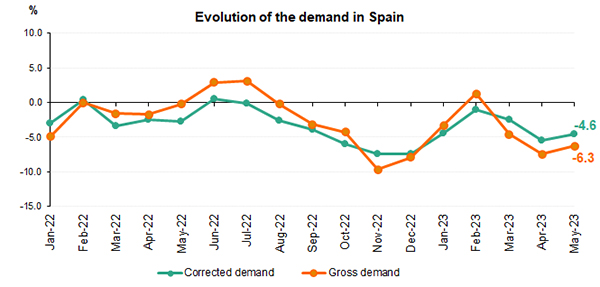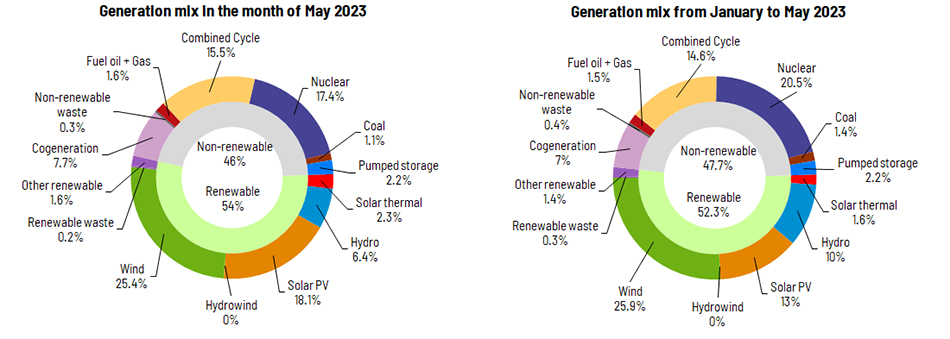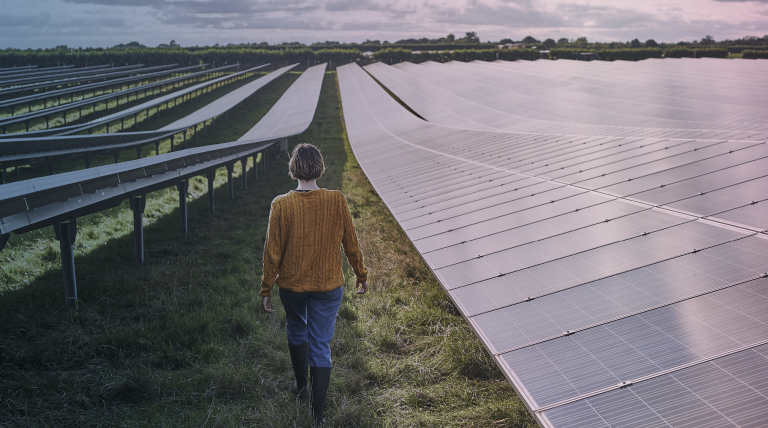For 40 years, we've been driving our country's economic and social progress. Four decades shaping Spain.
Demand for electricity in Spain fell 4.6% in May
- Renewables generated 54% of the country's electricity this month and 73.1% of the energy mix was obtained using zero-carbon energy technologies
- Wind and solar photovoltaic are the two technologies that have produced the most this month, with the latter occupying second position in the generation mix for the first time ever, with 18.1% of the total production
- Solar photovoltaic generation increased by 15.8% compared to May 2022, while wind power generation increased by 16.1%
National electricity demand in May experienced a 4.6% decrease year-on-year after having factored in the influence of seasonal and working patterns. In gross terms, demand is estimated at 19,026 GWh, down 6.3% on May 2022.

In the first five months of 2023, Spain recorded a cumulative demand of 100,038 GWh, 4% less than in the same period of 2022. Once again, after having factored in the influence of seasonal and working patterns, demand fell by 3.6% compared to 2022.
In May, according to data available at the time of this press release, renewable energy sources generated 4.8% more compared to the same month in 2022, reaching a total of 11,593 GWh, which represented a 54% share of the total generation mix. For its part, electricity production obtained using zero-carbon energy technologies accounted for 73.1% of the total.
For the seventh consecutive month, wind was the leading energy source with a production of 5,441 GWh and a share of 25.4% of the total mix. The contribution of wind power in this month increased by 16.1% year-on-year.
On the other hand, solar photovoltaic power ranked as the second technology within the national generation mix for the first time ever, accounting for a share of 18.1% of the total mix, with a record production of 3,883 GWh, which is 15.8% more than in May 2022.
Hydro, with a 6.4% share of the total production in May, generated 1,383 GWh this month, showing a decrease of 28.1% compared to the same month in 2022.

Demand for electricity in the peninsular system
Regarding the mainland electricity system, and after having factored in the influence of seasonal and working patterns, demand for electrical energy was 4.8% lower than in May 2022. In gross terms, demand stood at 17,838 GWh, down 6.6% year-on-year.
In the first five months of the year, electricity demand on the Spanish mainland stood at 94,278 GWh, a 4.2% decrease compared to 2022. Again, after having factored in the influence of seasonal and working patterns, demand decreased by 3.8%.
Renewable energy sources on the Spanish mainland accounted for 55.9% of the total energy mix, and production from zero-carbon energy technologies accounted for 76% of the total.
Wind and solar photovoltaic power also lead the generation mix in the mainland system, contributing 26.1% and 18.8% of the total, respectively. They both recorded notable increases of 16.2% and 16.1%, respectively, compared to May 2022.
Electricity demand in the Balearic Islands and the Canary Islands
Electricity demand in the Balearic Islands in May, after having factored in the influence of seasonal and working patterns, was 1.4% lower than in the same month in 2022. Thus, gross demand is estimated at 459,024 MWh, 2.7% lower than in May of last year. In the first five months of 2023, gross demand in the Balearic Islands is estimated at 2,157,408 MWh, down 2.5% compared to the same period in 2022.
In terms of generation, combined cycle, with 67.9% of the energy produced in the Balearic Islands, was the leading source in the islands in May. For its part, renewable energy obtained using zero-carbon energy technologies in the Balearic Islands represented 13.5% of the total. In addition, this month, the subsea link between the mainland and Majorca contributed to covering 25.9% of the electricity demand in the Balearic Islands.
For its part, and after having factored in the influence of seasonal and working patterns, electricity demand in the Canary Islands fell by 0.7% year-on-year. In gross terms, demand was 698,752 MWh, down 0.3%. In the first five months of 2023, demand in the Canary Islands is estimated at 3,456,894 MWh, up 0.2% compared to the same period in 2022.
In terms of electricity generation in the Canary Islands, combined cycle, with 39.5% of the total, was also the leading technology in May. Renewables and generation obtained using zero-carbon energy technologies produced 23.2% of the production this month, with wind generating 18.7% of the total.
Consult our Daily Balance Report for more information on the National, Peninsular, Balearic Islands and Canary Islands electricity systems as at the close of May.
Downloads












